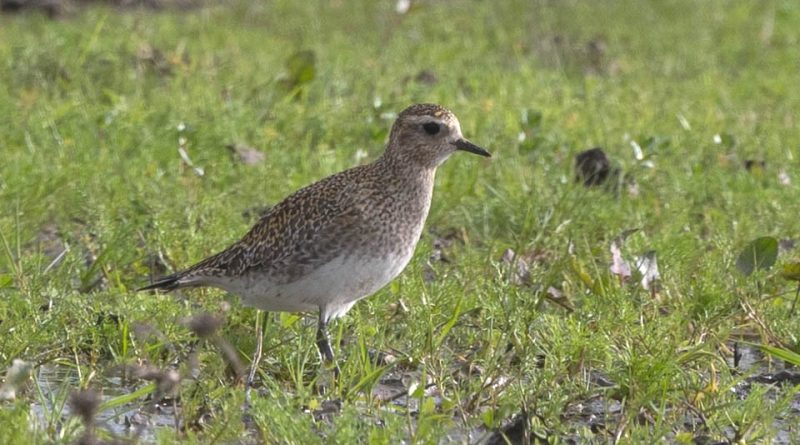Pluvialis apricaria
Pluvialis apricaria
The golden plover or European golden plover, European golden-plover, Eurasian golden plover (Pluvialis apricaria, Linnaeus 1758) is a bird belonging to the Charadriidae family.
Systematics –
From a systematic point of view it belongs to:
Eukaryota domain,
Kingdom Animalia,
Phylum Chordata,
Subphylum Vertebrata,
Aves class,
Order Charadriiformes,
Family Charadriidae,
Genus Pluvialis,
P. apricaria species.
The term is basic:
– Charadrius apricaria Linnaeus, 1758.
The terms are synonyms:
– Charadrius altifrons Brehm, 1831;
– Pluvialis apricaria subsp. albifrons;
– Pluvialis apricaria subsp. altifrons (C.L.Brehm, 1831);
– Pluvialis apricaria subsp. apricaria.
Geographic Distribution and Habitat –
The Pluvialis apricaria is a bird that nests in the Arctic tundra and heaths of northern Europe and northwestern Asia up to Kazakhstan and also in Greenland. During the winter it migrates to central and southern Europe, northern Africa, the Arabian Peninsula, Iran, Pakistan and Australia. Instead, this species is found in Canada and in the north-eastern United States, in Alaska, Mongolia, India, Syria, Yemen and Oman, and in western Africa south of Morocco up to Sierra Leone.
In Italy it is a species that migrates during the winter period, from October to November and from March to April but partly also as a winter visitor.
Its breeding habitat is the Arctic tundra and other Palaearctic areas, ranging from extreme west Iceland, where they are called Heiðlóa, and as far east as central Siberia.
Description –
The Pluvialis apricaria is a medium-small charadriform bird, weighing about 200 g and with slight sexual dimorphism.
The plumage has a color that varies from summer to winter. In summer, both chest and abdomen are black-brown with lateral white margins. In winter the general color is lighter and the dense golden spots are clearly visible, from which the name derives. In the female, the white summer margin is less evident.
The beak is short, straight; it has large eyes, a short and square tail, long tarsi, three toes joined at the base by a membrane.
The legs are tall and thin, with little or no big toe.
It has a fast flight and is a good runner; its flying action is swift and powerful, with regular wing beats.
The call is a monosyllabic, slightly descending and melancholic “tuu”.
Biology –
The habitat of this bird is essentially constituted by the arctic tundra and by heaths during the reproductive period while in migration and wintering it is found close to the marshes close to cultivated fields, banks of the rivers.
The reproductive period which goes from the end of April to June, is opened with the characteristic skirmishes of the males to conquer the territory which, once conquered, allows the female to choose the place where to build the nest while the male performs the nuptial parade.
After mating, the female lays 3-4 eggs on the ground which she hatches for about 27-29 days; the chicks leave the nest after a few hours and are looked after by both parents for 4 weeks.
Ecological role –
Pluvialis apricaria has an extremely large range and therefore does not approach the vulnerability thresholds of the species, based on the criterion of range size (extent of occurrence <20,000 km2 combined with a declining or fluctuating range size, extent/ habitat quality or population size and a small number of locations or severe fragmentation).
Although it is a common species, its population has been reduced in recent decades due to the destruction of its habitat. For example, during the 19th century it disappeared from Poland, where it nested, and currently appears only during the winter; the central European population apparently became isolated after the last ice age. (Tomek & Bochenski, 2005); in recent years the population seems to be increasing.
For these reasons, the species is evaluated by the IUCN as Least Concern.
It is a gregarious species which tends to gather in large flocks and overwinter in open areas, agricultural plains, plowed land and short meadows, ranging from Europe to North Africa.
Its diet consists essentially of earthworms, beetles, molluscs, small crustaceans, seeds and small berries which they find in tundras, fields, beaches and marshes, usually catching food by sight.
Pluvialis apricaria is one of the species covered by the Agreement on the Conservation of Migratory Waterbirds of Eurasian Africa (AEWA).
Guido Bissanti
Sources
– Wikipedia, the free encyclopedia.
– GBIF, the Global Biodiversity Information Facility.
– C.Battisti, D. Taffon, F. Giucca, 2008. Atlas of nesting birds, Gangemi Editore, Rome.
– L. Svensson, K.Mullarney, D. Zetterstrom, 1999. Guide to Birds of Europe, North Africa and the Near East, Harper Collins Publisher, UK.
Photo source:
– https://inaturalist-open-data.s3.amazonaws.com/photos/252155148/original.jpg


